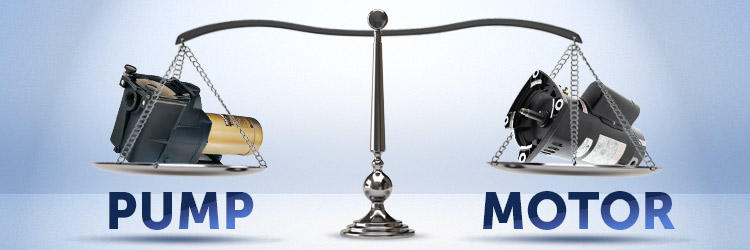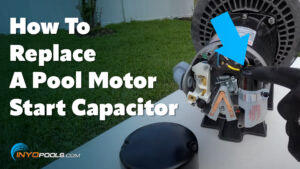If you’re reading this then there is a good chance that your pool pump is down, the anxiety is up and the algae monster is ready to pounce on your pool. After years in the pool industry, I can tell you many a homeowner has contacted us in a panic with a dead pump. The scenario usually goes as such: they or their tech has the pump apart and they are pondering the options that lay before them. They may know what they need but want to know if it’s worth the work to get the pump up and running. One of their major questions is, “Is it worth it to get a whole new pump or should I just get a motor?” The cost between a simple motor replacement and a pump installation can be sizeable. That difference in price makes it important for you and your wallet to know when to call it quits on an old pump.
Wreck-it or Recover it?
Our first step will be to determine the overall health of your pump. Over the years, this rugged piece of machinery has been subjected to blazing heat, driving rain and even lightning strikes. These conditions can drag down their overall health. The pump’s internal parts, as well as the housing and motor, can go bad and require replacement. When determining the magic number of replacement parts cost versus the cost of the whole pump, we generally suggest 60-75% as the standard. If the cost to repair is within or over this range, it is smarter to replace the pump. This way you have a brand new pump and warranty covering any mishaps down the line. There are a few other things to look out for when checking pump health. The key points are listed below.
- Dry Rotted or Cracked Housing – Besides a motor, the housing is the most expensive part of a pump to replace. If your housing is showing signs of deterioration, take a close look at the other parts of the pump. For example, the pump lid, basket, and impeller could be in need of repair as well. When totaling up the necessary replacement parts, keep in mind the magic number of 60-75%. If you get to that range, it could be time to replace the whole thing.
- Pumps older than 12-15 years – If it was a car you would have gotten rid of it by now. Sadly, unlike some vehicles, pumps do not appreciate in value as they get older. Pumps approaching this age see frequent breakdowns and repair. The cost of maintenance soon starts to outweigh the value of the old pump.
- Obsolete Parts – Some pumps for whatever reason are discontinued by their manufacturer. At that time, essential parts can be increasingly hard to find or unavailable. Review our pool parts section for your unit’s parts breakdown to determine their availability.
- Bronze or Cast Iron Pumps – Metal pumps were the standard for pools decades ago but they have been phased out. High strength composite materials have taken their place in the sun. The metal pump obsolescence has made parts hard to come by. If you are able to find the part, it will be at a premium.
Motors: Listen and Learn
If your pump’s wet end does not have any of the above red flags, a motor maybe your best option. First on the list when determining the status of your motor is to just be quiet and listen. The sound that follows a flick of the power switch can lend a big clue to what motor issues lie ahead. Motors, for the most part, are simple beasts. Once installed a motor needs little if any maintenance to keep it running. If a properly running motor starts to make any of the following noises, a replacement motor could be your next purchase.
- Loud Screech or Grinding – If your pump sounds less like an electrical motor and more like a Boeing Jet then your bearings are bad. Besides the age of the motor, these bearings can rust or freeze from the water inside the casing. The most common causes are a leaky shaft seal, flooding or even errant sprinkler spray. Bearings are the joints that spin the shaft freely or in this case cause you severe ear pain. The good thing is bearings can be replaced on the cheap. If you’re looking to go this route, then view our selection of pool motor bearings. If you do go this route keep in mind you will need a specialized tool called a bearing puller to remove the bearings.
- Humming Sound – Hmmm, what’s the cause? It’s the capacitor! This little barrel of fun stores an electrical charge to be dispersed to either kick start or keep your motor running. There are two types of capacitors, run (silver) and start (brown.) A blown capacitor is caused by a surge in power or overheating and is an easy fix for a handy homeowner. For the guide on replacing a capacitor, see our guide.
- Pop and a Click – Once your motor is tripping the breaker, it is on its last legs. When a motor is flipping the breaker, it is a sign of a deeper electrical issue.
- Silence – First check your power source. If that is fine then no, your pump is not resting. It’s dead. The silence is a sign that the inner workings of the motor have completely failed, i.e. the shaft has frozen. A motor that has reached this point is beyond repair.
Inspect your Gadgets
Legislators in pool heavy states like Arizona, California, Florida, and Texas have recently put strict regulations on replacement motors and pumps. The new regulations may require homeowners to upgrade their pump to dual or variable speed. The changeover to dual and variable speed pumps is meant to lessen the load on the electrical grid. The effect is also seen in the customer’s pocketbook. Dual speed and variable speed are designed to use less electricity thereby lowering your power bills. To help aid the transition, power companies are providing customer rebates when homeowners install new, qualifying motors. Check with your power company for the specific rebate details.
If you want more information on how these motors can save you money, read the following guides: How to Save Money Using a Variable Speed Motor or How to Replace a Single Speed Motor with a 2Green Motor













Leave a Reply